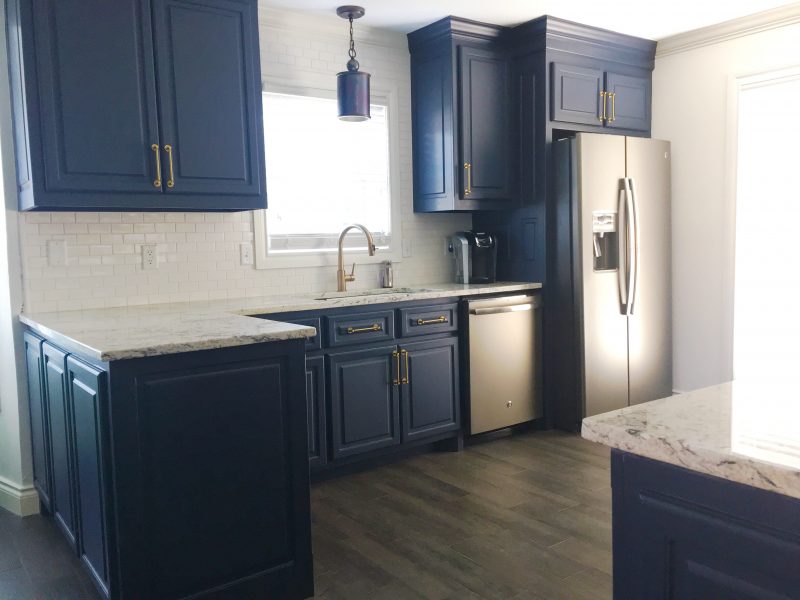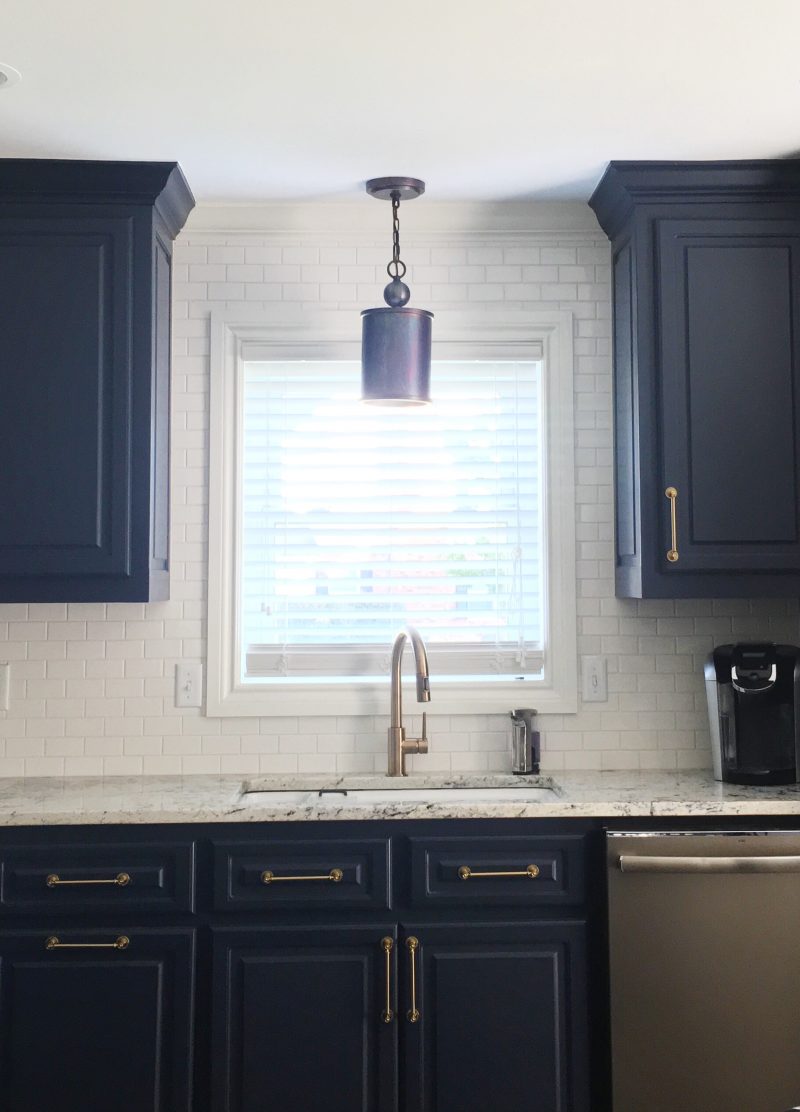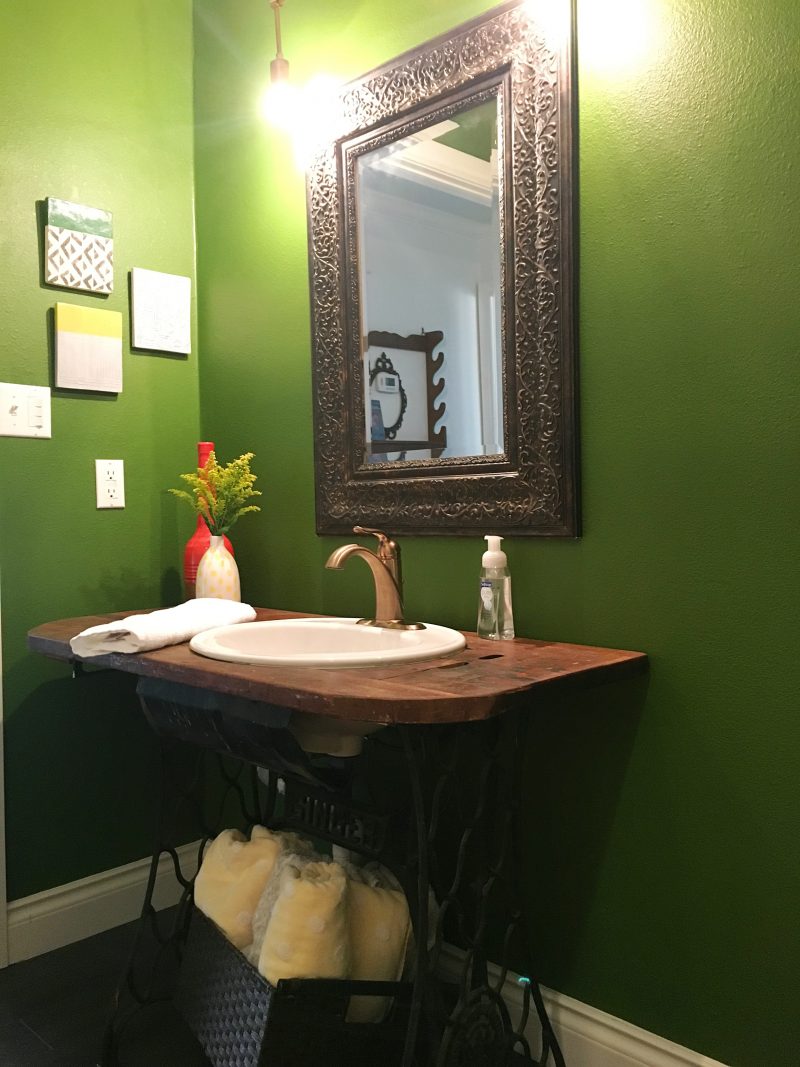 This post is basically when to be fancy and when to be basic. Keep in mind, these are my thoughts and what I use for myself, so you definitely don’t have to agree or even care about my rules. That being said, this post is my tell-all handbook for how I remodeled our home on a budget.
This post is basically when to be fancy and when to be basic. Keep in mind, these are my thoughts and what I use for myself, so you definitely don’t have to agree or even care about my rules. That being said, this post is my tell-all handbook for how I remodeled our home on a budget.
First, a little backstory. Our home flooded and left us with about ¼ of the items we owned and a completely demoed house. We saved the top ½ of the sheetrock, the studs, and the roof – actually, we ended up replacing the roof too. That’s pretty much it. After the initial shock, we were forced to start making all the decisions about rebuilding – basically our lives where a whirlwind of who, what, where, when, and how. (You can read about how that was a nightmare for me here.) Now that construction is finished, I thought I’d share a bit about how I made what decisions and where I chose to splurge versus not.
For this project, we had a budget. We basically had XX number of dollars to rebuild the entire house, do any upgrades we’d been dreaming about, AND replaced all of the personal items we lost. There was simply that number of dollars. We weren’t taking out a second mortgage or selling a car to pay for things. We had to make tough decisions CONSTANTLY about where to splurge and where to save.
An old adage to note here is, “you get what you pay for.” Most of us have heard that since the beginning of time and unfortunately for our pocketbooks, it’s true. We simply don’t get high quality items for pennies. This, of course, doesn’t count the occasional sale or lucky find. And, that being said, you can usually easily tell the difference in how the quality version of something performs compared to the lower quality one. I noticed this immediately with my car. It simply drives and feels different than any other vehicle I’ve ever had. This was a fact that I didn’t understand until I drove one myself, which was the day I drove it off the lot. Have I mentioned that I love that car?? I digress.
Back to the house. One of the first examples of quality difference that I noticed in the “new” house was the faucets. We chose to put Delta faucets and Kohler sinks throughout the entire house. (Please make a note of this if you’re considering buying my house in the future and you’re doing your research on the property. Upgrades throughout! A lovely place to call home! *wink wink*) Back to the faucets. When I first used the new kitchen faucet, I nearly swung it off the countertop because it swiveled so easily! The last faucet we had was much harder to rotate, and to be honest, I often thought I was going to break it. I was also super impressed with the new pull down sprayer. When I released it from spraying out the sink, it just popped right back into place and looked as beautiful as ever! After the first use on the last faucet, I felt like it never fit back together properly and you always had to force it back into place. It was better that what we had previously, though this Delta faucet makes the old one feel like an ugly stepchild. (No offense, ugly step children.) Expensive definitely doesn’t always equal quality. However, in most cases, the “pay for what you get” rule does apply.
 So, how does one know where to upgrade and where to not? I’m glad you asked. I feel like sort of an expert on this topic because I’ve always applied these principles in most areas of my life and used them daily lately. My wardrobe, for example, is a compilation of quality where necessary and inexpensive where people won’t notice. When it comes to the house, we splurged on some items like the faucets and I won’t splurge on other things like door mats or paper towel holders. I’ll wait until I find adorable options at a discount store like TJ Maxx or Ross. (So, stay out of those stores until I find all of the cute, cheap items that I need. Then you can return to your normal shopping pleasure.) Here are a few rules I applied to splurging on our house renovation that I’ve used over and over again in other areas too:
So, how does one know where to upgrade and where to not? I’m glad you asked. I feel like sort of an expert on this topic because I’ve always applied these principles in most areas of my life and used them daily lately. My wardrobe, for example, is a compilation of quality where necessary and inexpensive where people won’t notice. When it comes to the house, we splurged on some items like the faucets and I won’t splurge on other things like door mats or paper towel holders. I’ll wait until I find adorable options at a discount store like TJ Maxx or Ross. (So, stay out of those stores until I find all of the cute, cheap items that I need. Then you can return to your normal shopping pleasure.) Here are a few rules I applied to splurging on our house renovation that I’ve used over and over again in other areas too:
- Splurge on items that you use often. An example here would be the faucets. They’re touched and turned on and off every single day. Delta faucets even come with a lifetime warranty so if something goes wrong, you just call them. You don’t get that with cheaper brands. I also applied this principle to our bed which I’ll never, ever regret. We could have gotten a cheaper mattress. However, you spend almost half of your life in bed. That should definitely be an area to splurge. (If you need a suggestion for someone to talk to here locally, let me know!) A third example here is the washer and dryer. Even for just the two of us, I do a LOT of laundry. And I’m very, very particular about my clothes. (Ask my friends. “Yes, you may borrow this. Don’t mess it up and bring it back to me dirty so that I can wash it myself” is basically how those conversations always went.) By investing in a nice, larger washer/dryer, I have more options for caring for our clothes AND I’ve cut my laundry time in half by being able to do larger loads.
- Splurge on items that will otherwise deteriorate quickly. The first example that comes to mind here is towels. Sure, you can buy cheap towels at the dollar store. However, it’s important to think about how long they’ll last. Towels certainly fall into the first category too, because ideally (hopefully) you use them every day. While I’m not ordering imported, fancy towels from wherever you import fancy towels from, I certainly won’t buy the cheapest version. This way, the bath experience feels a tad more luxurious and the product will last longer. If you have to repeatedly replace the cheaper version of something, you’re likely spending more money and having more headaches than if you’d have just upgraded a bit in the first place.
- Splurge on items that you LOVE. Clearly, we can’t splurge on everything we love. If so, I’d basically own Anthropolgie. However, sometimes you come across something that speaks to you, even though it might cost a little more than a similar version. Most of the time when this happens, it’s probably something you’ll use repeatedly for years to come. For example, Matthew and I found a rug that we both liked and it was neutral enough and high enough quality that we knew we’d use it for years to come, even if it was in a different room later. We decided to spend a little extra there because based on the years we’d use it, the cost was completely justified. Get this though – when he got to the checkout counter, it was 50% off!! We didn’t even know it was on sale when we made the decision to purchase. *Insert 1,000 dancing emojis.*
- Splurge when the process of trying NOT to splurge is more trouble than it’s worth. This is a big one for me. If you’re not naturally anxious like me, you can probably skip this one. To be honest, this rule has only become part of my splurge versus not conversation since I married my super chill husband. One day when complaining about how I just couldn’t find an affordable version of *insert random object here,* he asked if I’d wasted enough time already looking for a deal that I could have just bought the original version. It was a light bulb moment for me. Time is definitely worth something and I might be sacrificing way too much of my time to save just $5, $10, or $20. Now, I try to ask myself – could the time I spend looking for a “deal” actually be costing me time. Could the time I’m using be used in a more productive or profitable way? If I realize that the answer is yes – it’d be better to spend $10 extra dollars here than driving across town, spending time and gas, then I “splurge.”
 Now, where should you not splurge? These “rules” will vary greatly depending on what’s important to you. If you’re passionate about soap dishes or kitchen sponges, then so be it. I’m just not, so these tips are based on my personal preferences. In a nutshell, I feel like you should generally avoid splurging on the less noticeable things. However, here are some more specifics:
Now, where should you not splurge? These “rules” will vary greatly depending on what’s important to you. If you’re passionate about soap dishes or kitchen sponges, then so be it. I’m just not, so these tips are based on my personal preferences. In a nutshell, I feel like you should generally avoid splurging on the less noticeable things. However, here are some more specifics:
- Do not splurge on trendy items. We’ve all seen it. One day everyone is raving about mesh wreaths and the next it’s wall weavings. Trends ebb and flow constantly. My general rule of thumb is to never, ever splurge on something too trendy. If it happens to fall into #3 above, then maaaybe. However, if you go all out on something too trendy and the trends change, your home is going to look dated instantly. You need to be able to practice “out with the old and in with the new” in regards to trends and if you’ve mortgaged the house on that item, it’s going to be a lot harder to do. Actually, while we’re at it, I generally try to avoid anything that’s gone mass trendy anyway. If everyone you know is using it/wearing it/has it, it’s probably going to be lame in a matter of minutes. If you struggle with picking what’s classic and cool (and not overly trendy), watch your artsy friends. They’ll be doing trends before they’re cool and then likely abandon them once they’re widespread. The moral of this story is to not splurge on trends. And to avoid gangbuster trends altogether (if you wanna be supa fly, that is).
- Do not splurge on the small stuff. I’ll use the paper towel holder as an example again. There is most likely a marble or handmade stone paper towel holder out there that is breathtakingly beautiful. And most likely, I’d love to have it. However, I’ve never hosted a party and had guest ooh and ahh over my paper towel holder. Or the rags that I clean with. Or the front door mat. Or the light switch covers. There are definitely high quality, expensive versions of these things out there and again, if they fall into #3 above, go for it. Chances are though, most people don’t even notice the small stuff. AND most of the time you can find nice, less expensive version of these items either at a discount store or on sale somewhere. I have never paid more than $10 for a door mat and I’m quite proud of that fact. Usually by waiting, you can come across cute versions of these smaller items for less money. It’s how I create balance.
- Do not splurge simply for the sake of splurging. I know some people who simply spend money for what seems like no reason. They buy the expensive versions of everything because they equate dollar signs with value and worth. I do believe that quality comes with higher prices the majority of the time. However, the quality of my light switch covers is just not important to me. If you find yourself splurging on every single thing or spending money just to spend it, you should probably speak to your therapist. And cut up those credit cards.
- Do not splurge on a temporary solution. If you desperately need a dresser to hold your unmentionables and you really, really want that vintage chifferobe that will take you a bit to find, don’t splurge on the temporary solution. Buy something that works alright for now so that you can replace it without hurt feelings and a hurt pocketbook when you find the thing you really want. Similarly, I wouldn’t suggest spending a ton on something that will only work in this one spot in this one house. If you won’t be able to reuse that item, then it probably shouldn’t be a splurge item. My most recent example is our master bedding. I think that it’s important to get your bedroom set up and comfortable ASAP after a move, or remodel in our case. I haven’t chosen my permanent bedding yet, and rather than spending a lot on something temporary, we purchased an Ikea duvet to use in the interim. The room will be “fixed” and functional for now, and when I find my permanent bedding, I won’t have wasted a ton of money on the temporary.
As I said above, these guidelines are just how I personally approach spending money on my home. These tips were fresh on my mind since I’ve been employing them every single day lately, so I thought I’d share with the class. There will sometimes be exceptions (but pay close attention to #3 on what NOT to do) and there will always be differences in budgets and opportunities. You might want to be jealous of my Delta faucets (cause they’re awesome). However, I’ll kindly remind you that I had to go through one of the most traumatic experiences of my life thus far to get those faucets. If I had to spell out the biggest thing for you to take away from this post, it would be this – never spend more money than you have and never, ever compare yourself and your situation to someone else’s. Save where you can and treat yo self sometimes. If you’d like some inspiration on building a lovely home on a budget, this book and her blog is a great resource.
If you have any guidelines that you follow when deciding when to splurge and when not to, I’d love to hear them. Most of us don’t have the luxury (or are responsible enough to not to use it) to simply buy whatever we want, whenever we want it. I’d imagine that we all have strategies that we use, maybe without even noticing it, when making purchasing decision. I’d love to hear your tactics!

